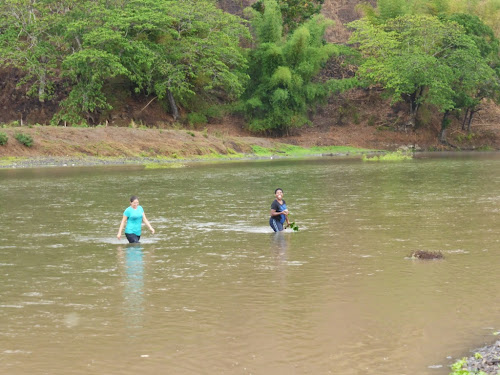Fiji has a reputation of being a country of cannibals, rightly so as in the olden days unwelcome visitors were killed and devoured. Luckily this practice is out of vogue today, or so we'd been told.
Although we'd been in Fiji for a week, we hadn't explored its many mountains or native forests at all. From our homestay in the Sigatoka River Valley we could see majestic limestone cliffs which calling our name, begging to be explored. A quick conversation with the Fijian ladies who work at the Homestay and we learned that the famous Naihehe cave was in the vicinity. And better yet, our host Monica hadn't been before and was eager to take us.
Following the local customs, we went in search of kava to present to the village at the base of the cave. We found it for sale in the home of an Indian man, who wrapped it up nicely for us for $15 Fijian (about $7.50US).
Kava is a local root crop that when ground up and mixed with water produces an intoxicating brew. Fijians have been drinking kava for centuries and it plays an important role in local rituals and rites of passage, as well as your typical Saturday night drinking binge.
With the kava in hand, we arrived in the appointed village to ask permission to visit the cave. Normally, one of the three of us would present the kava, but although Monica speaks Fijian, she was not familiar with this ceremony and Josh and I were totally helpless knowing only hello (Bula!) and thank you (vinaka) in Fijian. A village man, who would later serve as our cave guide, offered to present the kava to his village members on our behalf. Phew!
We took off our flip flops and entered the large house. The floors were covered in tightly woven rugs made out of pandanus leaves and we sat cross-legged on the floor in a circle. Mark, our appointed representative, spoke slowly in Fijian, offering the kava as a gift, praising the village and asking that we be invited to enter their ancestral cave as friends of the village. He then handed the wrapped kava to another man who turned the it over and over in hands, saying words I did not understand but seemed to be positive. The ceremony ended with everyone smiling and us being allowed to tour the caves with Mark as our guide.
Mark presenting the kava (wrapped in newspaper and a red plastic bag).
We four loaded into our rental car and drove a short ways down a muddy road to the edge of the wide but shallow Sigatoka River. Rather than pay to take a local bilibili raft across the river, we opted to wade and the cool water felt wonderful on our hot legs.
On our hike to the cave we passed an Indian family farming tobacco, climbed up a dirt slope, walked along a gravel road wide enough for two vehicles, and tromped along a narrow path in the rain forest. Finally we made it to the cave entrance, just as it began to sprinkle. We ducked into the cave with our headlamps in hand and walked in a shallow creek through the cave's various rooms.
Naihehe cave is the most famous cave in Fiji and it was the stronghold of the Saubatu people during the days of tribal warfare. When under siege, the entire Saubatu village would take refuge in the cave, staying there for 2-3 weeks at a time without any difficulty. They wisely kept the cave stocked with food and sleeping mats, among other things, so they could run and hid there at a moment's notice. It is said that during the last great battle, the Saubatu people holed up in the cave for 100 days and 100 nights, relying on a gap in the the ceiling of the largest room which they climbed up to on vines so they could resupply with root crops and fruits from above. They also enjoyed freshwater prawns and fish that swam in the river running the cave.
A little prawn caught while swimming through the cave.
Inside the cave are several large "rooms" which became the village's sleeping quarters, living room, dining room, and kitchen. There is also a raised stage from where the chief would give orders. And there was an area where kidnapped enemies were murdered, cooked and eaten. Fijians were canibals after all.
The cave is also home to some lovely limestone formations. (Yes, they really did sparkle.)
As we grew closer to the cave's exit, we could hear the rain. It was falling in buckets, like a nice, high-pressure shower. Except we weren't dressed for the rain. Still it was warm and we didn't care about getting wet. We laughed with a child-like glee, wrapped our electronics in plastic bags that we picked up on the way in (discarded litter was finding a higher use) and sloshed our way back towards the car. We even got to slide down a muddy slope, courtesy of gravity and the recent rainfall. I haven't laughed so hard in ages!
Luckily we could wash off all the mud in the river. By the end of the day, we had survived a cannibal cave, torrents of rain and a slippery muddy rebirth. What an adventure!







No comments:
Post a Comment